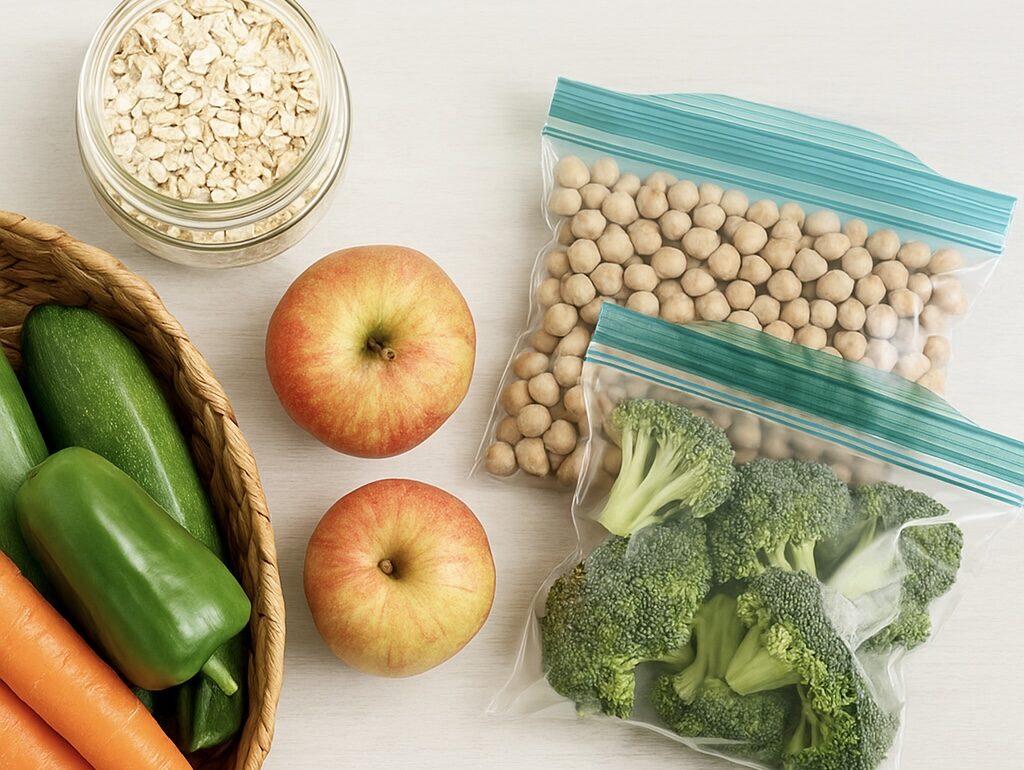
Making healthy choices for your family doesn’t have to mean spending a fortune. In fact, with a few practical habits and some smart planning, eating well and living well can fit beautifully into even the tightest budget.
Whether you’re navigating rising food costs or simply trying to make better choices without the overwhelm, here are some realistic ways to prioritize health without breaking the bank — and yes, it can be done.
1. Plan Your Meals Ahead of Time
Meal planning is one of the most effective ways to save money and reduce waste. It helps you avoid impulse buys, makes grocery shopping faster, and takes the guesswork out of “what’s for dinner?”
My experience:
I always plan for a week’s worth of meals, and it keeps me on track both budget-wise and mentally. It takes so much pressure off during the week when I already know what I’m making and what I have on hand. It’s seriously a game-changer.
2. Shop in Season and Buy Local
Seasonal fruits and vegetables are not only cheaper, but they’re also fresher and more flavorful. Local farmer’s markets or small grocers often have better prices and higher quality produce than big-box stores.
My experience:
Walmart doesn’t always offer many fresh deals, but Fry’s and Sprouts Farmer’s Market are my go-tos. I’ve learned where the weekly deals are and try to get a chunk of my shopping done there. Don’t be afraid to shop at multiple stores — it really is one of the best ways to save money.
3. Embrace Plant-Based Meals
Beans, lentils, rice, and vegetables are budget-friendly, filling, and full of nutrition. Skipping meat just a few nights a week can make a big difference on your grocery bill — and it’s better for your health, too.
My experience:
Beans and potatoes are non-negotiables in my meal plan. They’re cheap, comforting, and can stretch across multiple meals. I love making black bean tacos, chickpea burgers, or a hearty potato bake — so simple, so good, and so satisfying.
4. Cook in Bulk
Batch cooking helps you stretch ingredients further and saves time during busy weeks. Think soups, rice dishes, casseroles, and freezer-friendly meals.
My experience:
Cooking in bulk is my secret weapon. I’ll make a bunch of breakfast burritos, a big pot of quinoa mixed with cucumbers and onions, or quesadillas for quick lunches. It helps me stay on track, eat healthier, and avoid those last-minute fast food runs.
5. Buy Store Brands
Generic or store-brand items are usually less expensive than name brands — and most of the time, the quality is just as good.
My experience:
While I’m not against spending a little more for better quality, I’ve found that brands like Sprouts and Simple Truth offer amazing quality at a much better price. Sometimes, store-brand really is the better choice.
6. Incorporate More Whole Foods
Whole foods like fruits, vegetables, grains, and legumes give you more nutrients for your dollar. Processed foods may seem convenient, but they often cost more and leave you feeling less satisfied.
My experience:
There should never be more boxed snacks in your cart than real fruits and veggies. I’ll grab a few organic snacks for the kids, sure — but fresh produce is the heart of every grocery trip. When you build meals around whole foods, your body and your wallet both win.
7. Use Coupons and Shop Sales
Look for weekly sales, digital coupons, or loyalty rewards from your favorite grocery stores. A little bit of effort here adds up fast.
My experience:
I always check Fry’s and Sprouts for weekly deals — they usually have great specials and digital coupons that save me money. Don’t skip this step; it takes minutes and pays off big time.
8. Grow Your Own Herbs and Vegetables
Even if you don’t have a yard, a small container garden on a patio or balcony can help you save money and eat fresher.
My experience:
This is something I’m just getting started with, and I’m so excited to learn as I go. I’ve grown mint before and loved it — and now I’m putting my balcony space to good use growing more herbs and veggies. It’s fun, rewarding, and way cheaper than buying fresh herbs weekly.
9. Stay Active with Home Workouts
Gym memberships can be expensive — but movement is free. Walking, stretching, dancing, or doing free online workouts at home can make a big impact on your health and mood.
My experience:
Walking with my family is one of my favorite forms of exercise. It gives us time to laugh, talk, and connect — all while staying active. We’ve also done YouTube workouts together, and they’re fun and super effective (especially the silly ones with music!).
10. Be Mindful of Your Spending
Being intentional with your money doesn’t mean you can’t enjoy life — it just means you’re putting thought behind every dollar.
My experience:
This one took time for me. At first, sticking to a budget felt restrictive, but now it feels empowering. The more I stick to the plan, the easier it becomes. And honestly, there’s nothing more satisfying than staying within budget and still feeling like you provided healthy meals for your family.
Final Thoughts
Being healthy doesn’t have to mean fancy ingredients, expensive superfoods, or pricey gym memberships. Sometimes, it’s the simple stuff — the beans, the potatoes, the walks after dinner — that create the most lasting change. Don’t underestimate the power of small, steady steps. Whether you’re cooking more at home, growing herbs on your balcony, or swapping meat for beans once a week, it all adds up.
You’re doing better than you think — and your body, your family, and your budget will thank you.











Leave a Comment